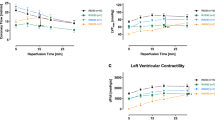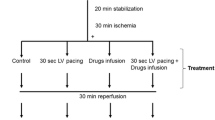Summary
To evaluate the hypothesis that maintenance of the integrity of myocardial membrane systems and prevention of Ca2+ influx into the cell are significant in the survival of ischaemic tissue, the effect of trifluoperazine and lysolecithin, were tested on the recovery of globally ischaemic rat hearts. Trifluoperazine increases membrane stabilization, inhibits calmodulin and binds to other Ca2+-dependent proteins. Lysolecithin, on the other hand, has a detergent action on myocardial cell membranes and facilitates Ca2+ ingress in ischaemic tissue. With trifluoperazine (2.45 μM), added before induction of ischaemia or during reperfusion only, hearst subjected to 40 min normothermic ischaemic cardiac arrest recovered mechanically. Untreated hearts failed after 20 min of ischaemia. The drug had no effect on tissue high energy phosphate levels or mitochondrial oxidative phosphorylation. Conversely, lysolecithin (2.5–10 μM) caused all hearts to fail after being subjected to 15 min ischaemia. Mechanical failure during reperfusion of such hearts was associated with a significant reduction in tissue ATP and CrP levels. Trifluoperazine counteracted the harmful effects of lysolecithin to a limited extent.
Similar content being viewed by others
References
Campbell KP, MacLennan D (1982) A calmodulin-dependent protein kinase system from skeletal muscle sarcoplasmic reticulum. Journal of Biological Chemistry 257:1238–1246
Corr PB, Cain ME, Witkowski FX, Price DA, Sobel BE (1979) Potential arrhythmogenic electrophysiological derangements in canine Purkinje fibers induced by lysophosphoglycerides. Circulation Research 44:822–832
Edoute Y, Graney D, Sanan D, Kotze JCN, Lochner A (1981) Effects of propranolol on myocardial ultrastructure, mitochondrial function and high energy phosphates of working rat hearts with coronary artery ligation. Journal of Molecular and Cellular Cardiology 13:619–639
Edoute Y, Van der Merwe E, Sanan D, Kotzé JCN, Steinmann C, Lochner A (1983) Normothermic ischaemic cardiac arrest of the isolated working rat heart: effects of time and reperfusion on myocardial ultrastructure, mitochondrial oxidative function and mechanical recovery. Circulation Research 53:663–678
Edoute Y, Van der Merwe EL, Sanan D, Kotzé JCN, Van Niekerk I, Lochner A (1983) Normothermic ischaemic cardiac arrest and reperfusion of the isolated working heart: effect of chlorpromazine on functional, metabolic and morphological recovery. Journal of Molecular and Cellular Cardiology 15:603–610
Hearse DJ, Garlick PB, Humphrey SM (1977) Ischaemic contracture of the myocardium: mechanism and prevention. American Journal of Cardiology 39:986–993
Jennings RB, Ganote CE (1974) Structural changes in myocardium during acute ischaemia. Circulation Research 35, Supplement 3:156–172
Landry Y, Amellal M, Ruckstuhl M (1981) Can calmodulin inhibitors be used to probe calmodulin effects? Biochemical Pharmacology 14:2031–2032
Lee Y, Chang S (1977) Effect of lysolecithin on the structure and permeability of lecithin bilayer vesicles. Biochemistry 16:1303–1309
Mulder EJ, Van den Berg WO, Van Deenen LLM (1965) Metabolism of red-cell lipids. I Conversion of lysophosphoglycerides. Biochimica et Biophysica Acta 106:118–127
Nayler WG, Poole-Wilson PA, Williams A (1976) Hypoxia and calcium. Journal of Molecular and Cellular Cardiology 11:683–706
Neely JR, Feuvray D (1981) Metabolic products and myocardial ischaemia. American Journal of Pathology 102:282–291
Raess BU, Vincenzi FF (1980) Calmodulin activation of the red blood cell (Ca2++Mg2+)-ATPase and its antagonism by phenotiazines. Molecular Pharmacology 18:253–258
Reimer KA, Jennings RB, Tatum AH (1983) Pathobiology of acute myocardial ischemia: metabolic, functional and ultrastructural studies. American Journal of Cardiology 52:72A-81A
Schaffer SW, Burton KP, Jones HP, Oei HH (1983) Phenotiazine protection in calcium overload-induced heart failure: a possible role for calmodulin. American Journal of Physiology 244:H328-H334
Schatzman RC, Wise BC, Kuo JF (1981) Phospholipid-sensitive calcium-dependent proteinkinase: inhibition by antipsychotic drugs. Biochemical Biophysical Research Communications 98:669–676
Sedlis SP, Corr PB, Sobel BE, Ahumada GG (1983) Lysophosphatidyl choline potentiates Ca2+ accumulation in rat cardiac myocytes. American Journal of Physiology 244:H32-H38
Seeman P (1972) The membrane actions of anesthetics and tranquilizers. Pharmacological Review 24:583–655
Snyder DW, Crafford WA Jr, Glashow JL, Rankin D, Sobel BE, Corr PB (1981) Lysophosphoglycerides in ischemic myocardium effluents and potentiation of their arrhythmogenic effects. American Journal of Physiology 241:H700-H707
Sobel BE, Corr PB, Robison AK, Goldstein RA, Witkowski FX, Klein MS (1978) Accumulation of lysophosphoglycerides with arrhythmogenic properties in ischemic myocardium. Journal of Clinical Investigation 62:546–553
Wildental K (1978) Lysosomal alterations in ischemic myocardium: result or cause of myocellular damage? Journal of Molecular and Cellular Cardiology 10:595–603
Witter RF, Morrison A, Shepardson GR (1957) Effect of lysolecithin on oxidative phosphorylation. Biochemica et Biophysica Acta 26:120–129
Author information
Authors and Affiliations
Rights and permissions
About this article
Cite this article
Lochner, A., van Niekerk, I. & Kotzé, J.C.N. Normothermic ischaemic cardiac arrest of the isolated perfused rat heart: effects of trifluoperazine and lysolecithin on mechanical and metabolic recovery. Basic Res Cardiol 80, 363–376 (1985). https://doi.org/10.1007/BF01908180
Received:
Issue Date:
DOI: https://doi.org/10.1007/BF01908180




